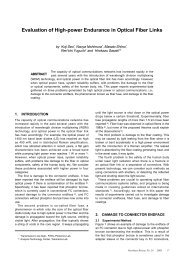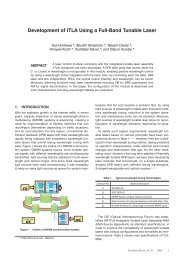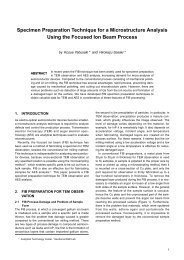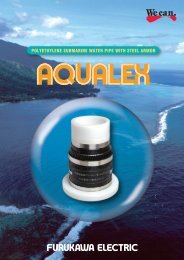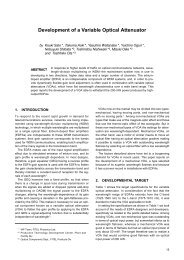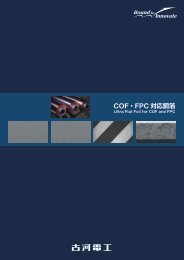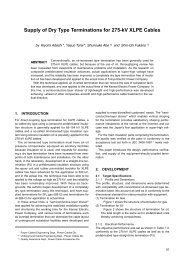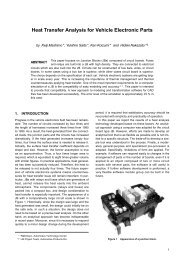Development of a 500-kV DC XLPE Cable System
Development of a 500-kV DC XLPE Cable System
Development of a 500-kV DC XLPE Cable System
You also want an ePaper? Increase the reach of your titles
YUMPU automatically turns print PDFs into web optimized ePapers that Google loves.
<strong>Development</strong> <strong>of</strong> a <strong>500</strong>-<strong>kV</strong> <strong>DC</strong> <strong>XLPE</strong> <strong>Cable</strong> <strong>System</strong><br />
<br />
<br />
<br />
<br />
<br />
<br />
<br />
<br />
<br />
<br />
<br />
<br />
Figure 1 Volume resistivity <strong>of</strong> <strong>XLPE</strong> materials.<br />
<br />
<br />
<br />
<br />
<br />
Figure 3<br />
<br />
<br />
<br />
<br />
<br />
<br />
<br />
Short term breakdown characteristics <strong>of</strong><br />
model cables.<br />
<br />
<br />
<br />
<br />
<br />
<br />
<br />
<br />
<br />
<br />
<br />
<br />
3.2 Long-term Electrical Properties<br />
Long-term tests were carried out on a model cable using<br />
<strong>DC</strong>-<strong>XLPE</strong> to confirm that the “n” value <strong>of</strong> the inverse<br />
power law for the model cable under <strong>DC</strong> voltage was<br />
15 or higher, and that the model cable had an “n” value<br />
equal to that <strong>of</strong> an ultra high voltage <strong>XLPE</strong> cable 1) .<br />
We were able to obtain satisfactory results from the<br />
model cables in terms <strong>of</strong> both the short-term breakdown<br />
characteristics and long-term characteristic stability <strong>of</strong> the<br />
<strong>DC</strong>-<strong>XLPE</strong> developed here.<br />
Figure 2<br />
<br />
<br />
Space charge characteristics <strong>of</strong> <strong>XLPE</strong> materials.<br />
accumulation <strong>of</strong> space charges in specific regions<br />
close to the inner semiconductive layer. On analysis we<br />
have found that the subject <strong>XLPE</strong> satisfies the electric<br />
insulation requirements for <strong>DC</strong> <strong>XLPE</strong> cable.<br />
3. ELECTRICAL CHARACTERISTICS OF<br />
MODEL CABLES<br />
We examined the dielectric breakdown characteristics<br />
<strong>of</strong> model cables to investigate the subject <strong>DC</strong>-<strong>XLPE</strong><br />
material.<br />
3.1 Breakdown Characteristics<br />
Dielectric breakdown test in the model cables was carried<br />
out under the following conditions.<br />
Test sample:<br />
conductor size: 200 mm 2<br />
insulation thickness: 9 mm<br />
Test temperature: 90°C at conductor (∆T=20°C)<br />
Here, ∆T means the temperature difference between<br />
the conductor and the shielding layer.<br />
Figure 3 plots dielectric breakdown strength for<br />
<strong>DC</strong>-<strong>XLPE</strong> vs. AC-<strong>XLPE</strong>, showing that <strong>DC</strong>-<strong>XLPE</strong> clearly<br />
surpasses AC-<strong>XLPE</strong> in <strong>DC</strong> breakdown strength. Thus the<br />
<strong>DC</strong>-<strong>XLPE</strong> has better characteristics than the AC-<strong>XLPE</strong><br />
from the standpoint <strong>of</strong> short-term operation in <strong>DC</strong><br />
breakdown strength.<br />
3.3 Space Charges<br />
3.3.1 Under low electric field<br />
We investigated the space charge characteristics <strong>of</strong><br />
the model cable in a low electric field equivalent to an<br />
operating field.<br />
A pulsed electroacoustic method 6) was applied to<br />
measure the space charges, where the electric field<br />
distribution was calculated based on the measured space<br />
charge distribution. The test conditions were as follows:<br />
Test sample:<br />
conductor size: 100 mm 2<br />
insulation thickness: 3 mm<br />
Test temperature: 90°C at conductor<br />
Applied electric field: 30 <strong>kV</strong>/mm<br />
Application time: 2,160 h<br />
Figure 4 plots the electric field distribution for a<br />
<strong>DC</strong> <strong>XLPE</strong> cable, while Figure 5 plots the electric field<br />
distribution for an AC <strong>XLPE</strong> cable.<br />
Figure 4 indicates that the <strong>DC</strong> <strong>XLPE</strong> cable incurred<br />
scarcely any accumulation <strong>of</strong> space charges at the<br />
outset <strong>of</strong> voltage application, and the consequent electric<br />
field distribution was determined by the electrostatic<br />
capacitance. Yet, over time, we see a trend toward a<br />
wide-spread accumulation <strong>of</strong> negative charges in the<br />
insulation due to the injection <strong>of</strong> charges from the inner<br />
semiconductive layer. Consequently, the electric field<br />
distribution increases on the outer semiconductive<br />
layer side and decreases on the inner side. This pattern<br />
<strong>of</strong> electric field distribution is almost the same as that<br />
determined by resistivity, for instance in an OF cable.<br />
Figure 5 clearly indicates that even a cable using<br />
AC-<strong>XLPE</strong> induces an electric field distribution not<br />
Furukawa Review, No. 25 2004 48





